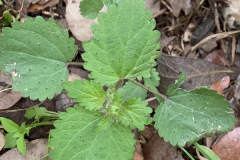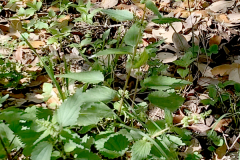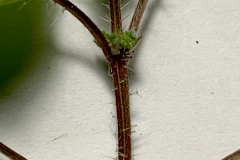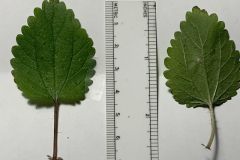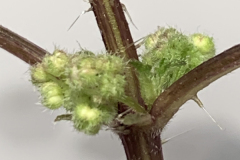Heartleaf Nettle, Fireweed
Urtica chamaedryoides
Urticaceae
Description
A common, erect (most plants ~12” high); greenish to red square-stemmed very green forb. It has long-petioled, opposite, ovate, leaves with serrated margins. Stinging hairs are present on leaf and stem surfaces and virtually all plant parts. Their structure is a bulbous base containing an irritating substance and a brittle, sharp shaft which injects the toxin upon touch. It can cause a painful irritation lasting several days. The flowers lack colorful petals since it is a wind-pollinated species. Thus the axillary globular flower-heads are rather inconspicuous but their four sepals do have stinging hairs. The plant can be monoecious or dioecious. Heartleaf Nettle is a host plant for Red Admiral and Question Marks as well as Painted Lady, Eastern Comma, and Mourning Cloak butterflies. Its tiny seeds are sticky and probably adhere to passing animals as a dispersal mechanism. It generally disappears with the coming of summer temperatures.Habitat
Prefers moist, shaded, rocky sites.Toxic Agent
Histamine, acetylcholine, serotoninSigns of Livestock Ingestion
Cattle will generally avoid Heartleaf Nettle.Management Strategies
This species will die back naturally in hot weather.Images
Plant Characteristics
Flower Color: Green
Seed Type: Achene
Duration: Annual
Stem Texture: Hairy, Square
Growth Habit: Forbs/Broadleaf
Leaf Shape
 : Simple with Pinnate or Parallel Venation
: Simple with Pinnate or Parallel Venation
Season: Cool
Distribution
 : 01 - Pineywoods, 02 - Gulf Prairies and Marshes, 03 - Post Oak Savannah, 04 - Blackland Prairies, 05 - Cross Timbers and Prairies, 06 - South Texas Plains, 07 - Edwards Plateau, 09 - High Plains
: 01 - Pineywoods, 02 - Gulf Prairies and Marshes, 03 - Post Oak Savannah, 04 - Blackland Prairies, 05 - Cross Timbers and Prairies, 06 - South Texas Plains, 07 - Edwards Plateau, 09 - High Plains
Distributions
Distribution refers to the ecological region in Texas that a plant has been found. You can also view a clickable map.
Collection: Brush and Weeds
Livestock Affected: Dogs, Horses
Livestock Signs: Abnormal Heartbeat, Depression/ Weakness, Excess Salivation, Irregular Breathing, Pawing at the mouth, Vomiting/Regurgitation
